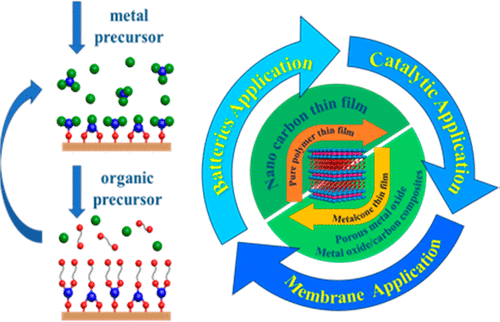当前位置:
X-MOL 学术
›
ACS Energy Lett.
›
论文详情
Our official English website, www.x-mol.net, welcomes your
feedback! (Note: you will need to create a separate account there.)
Molecular Layer Deposition for Energy Conversion and Storage
ACS Energy Letters ( IF 19.3 ) Pub Date : 2018-03-06 00:00:00 , DOI: 10.1021/acsenergylett.8b00145 Yang Zhao 1 , Xueliang Sun 1
ACS Energy Letters ( IF 19.3 ) Pub Date : 2018-03-06 00:00:00 , DOI: 10.1021/acsenergylett.8b00145 Yang Zhao 1 , Xueliang Sun 1
Affiliation

|
The development of nanoscale coatings with well-controlled properties is critical to the future of nanotechnology for energy applications. As an extension of atomic layer deposition (ALD), molecular layer deposition (MLD), has recently emerged as a thin-film coating technique that can enable the development of high-performance materials in energy-related applications. MLD fabrication can be classified into two categories: polymer-based organics and inorganic–organic hybrid materials. The unique properties of low growth temperature, precise control of film thickness, uniformity, flexibility, and low density make MLD films very promising for energy-related applications. In this Review, we focus on the recent developments and understanding of MLD in the application of batteries, supercapacitors, water splitting, photodegradation, solar cells, and membranes. The different types of MLD films and nanomaterials derived from MLD are discussed based on the specific application and properties. Finally, the future direction of MLD in energy-related applications has been further investigated.
中文翻译:

用于能量转换和存储的分子层沉积
具有良好控制性能的纳米级涂料的开发对于能源应用纳米技术的未来至关重要。作为原子层沉积(ALD)的扩展,分子层沉积(MLD)最近已成为一种薄膜涂层技术,可以在能源相关应用中开发高性能材料。MLD的制造可分为两类:聚合物基有机物和无机-有机杂化材料。低生长温度,膜厚度的精确控制,均匀性,柔韧性和低密度的独特特性使MLD膜非常适合与能源相关的应用。在这篇评论中,我们重点介绍MLD在电池,超级电容器,水分解,光降解,太阳能电池,和膜。根据具体的应用和性能,讨论了不同类型的MLD薄膜和衍生自MLD的纳米材料。最后,对MLD在能源相关应用中的未来方向进行了进一步研究。
更新日期:2018-03-06
中文翻译:

用于能量转换和存储的分子层沉积
具有良好控制性能的纳米级涂料的开发对于能源应用纳米技术的未来至关重要。作为原子层沉积(ALD)的扩展,分子层沉积(MLD)最近已成为一种薄膜涂层技术,可以在能源相关应用中开发高性能材料。MLD的制造可分为两类:聚合物基有机物和无机-有机杂化材料。低生长温度,膜厚度的精确控制,均匀性,柔韧性和低密度的独特特性使MLD膜非常适合与能源相关的应用。在这篇评论中,我们重点介绍MLD在电池,超级电容器,水分解,光降解,太阳能电池,和膜。根据具体的应用和性能,讨论了不同类型的MLD薄膜和衍生自MLD的纳米材料。最后,对MLD在能源相关应用中的未来方向进行了进一步研究。











































 京公网安备 11010802027423号
京公网安备 11010802027423号